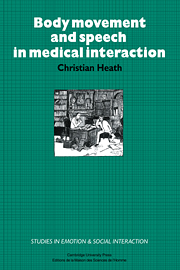Book contents
- Frontmatter
- Contents
- Preface
- The transcription system
- 1 Video analysis: interactional coordination in movement and speech
- 2 The display of recipiency and the beginning of the consultation
- 3 Maintaining involvement in the consultation
- 4 Forms of participation
- 5 The physical examination
- 6 Taking leave of the doctor
- 7 Postscript: the use of medical records and computers during the consultation
- Notes
- References
- Index
4 - Forms of participation
Published online by Cambridge University Press: 19 January 2010
- Frontmatter
- Contents
- Preface
- The transcription system
- 1 Video analysis: interactional coordination in movement and speech
- 2 The display of recipiency and the beginning of the consultation
- 3 Maintaining involvement in the consultation
- 4 Forms of participation
- 5 The physical examination
- 6 Taking leave of the doctor
- 7 Postscript: the use of medical records and computers during the consultation
- Notes
- References
- Index
Summary
“Participation framework.” When a word is spoken, all those who happen to be in perceptual range of the event will have some sort of participation status relative to it. The codification of these various positions and the normative specification of appropriate conduct within each provide an essential background for interaction analysis-whether (I presume) in our own society or any other.
Goffman 1981, p. 3A change in footing implies a change in the alignment we take up to ourselves and the others present as expressed in the way we manage the production or reception of an utterance. A change in our footing is another way of talking about a change in our frame of events.… Participants over the course of their speaking constantly change their footing, these changes being a persistent feature of natural talk.
Ibid., p. 128The method consists of treating an actual appearance as “the document of,” as “pointing to,” as “standing on behalf of” a pre-supposed underlying pattern. Not only is the underlying pattern derived from its individual documentary evidences, but the individual documentary evidences, in their turn, are interpreted on the basis of “what is known” about the underlying pattern. Each is used to elaborate the other.
Garfinkel 1967, p. 78In previous chapters it has been suggested that by turning towards the face of another a person may display his or her willingness to receive an action or activity. So for example it is found that during the course of an utterance a speaker may withhold talk until the potential recipient has turned his gaze and thereby displayed attention to the actions of the speaker.
- Type
- Chapter
- Information
- Body Movement and Speech in Medical Interaction , pp. 76 - 98Publisher: Cambridge University PressPrint publication year: 1986



